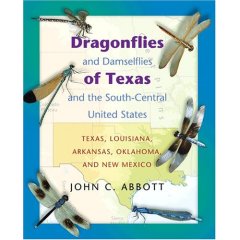
Dr. Abbott's book Dragonflies and Damselflies of Texas and the South Central United States is a great reference. I use it to make my initial guess and then I go to the website to view the photo gallery for the species. The book is arranged by the scientific organization. Hopefully eventually I will get more familiar with each type of damsel and dragonfly. While geared toward the south central United States, I think this would be a great reference for other people.
The website is dynamic and continues to add new species and records for new species. And this is where people like some of you and me can help out. The New Records section is a place to document which species are found where and when in Mexico, United States, Canada. I know some of you reading this are elsewhere in the world, but don't let that deter you . . . . Here is how these records work, people like us who take photographs can submit records to this growing database. To submit a record, you need to be able to identify your dragonfly or damsellfly. You must have records as to where you photographed it and the date. With digital cameras date and time is easy. Since I keep my photo records filed by where and when I took them, I can go back two or three years and send in my dragonfly data. Now he prefers latitude and longitude of your sighting or certainly the county (if in the United States). But he also has a link to Google Maps which will help you get the proper latitude and longitude for your sighting. You can also collect your species, but there are rules - you need to preserve them in acetone - there are instructions . . . . Also, there may be local rules and regulations concerning collecting specimens - some places you need a scientific license to do so.
Now if you are outside the United States, Mexico, and Canada, I think he is still interested in getting your data. If you have dragonfly photos with all the necessary information, contact him and perhaps he can add your region to his data base. His contact information is on the website.
The cool thing about this is that your photos can help expand the knowledge base about dragonflies and damselflies. Your photos could be used in the gallery (with your permission, of course). And it could be a chance to get published when he is working on his field guide or other future books. His budget is slim - you won't get paid, but publication in a scientific book would please me no end.
When I get a chance, I'm heading up to the Texas Panhandle, an area that has not been studied because it is such a dry, barren looking area. But I know where many permanent water sources are up there, so if I took the time, I'm thinking I could get several records (being the first one to document a sighting in a particular place.)
One last thing, all photos or specimens are verified - if you have improperly identified a species, it won't make the count. I've mentioned adding a "critique" type gallery where people who are not experts at identification could get help knowing what species their photo is before uploading as a new record.
This website is truly a pioneer effort in how effectively one can use the web as a source in identifying and studying animal families. I think it will be a template for other websites on birds, mammals, tropical fish, etc in the future.
No comments:
Post a Comment